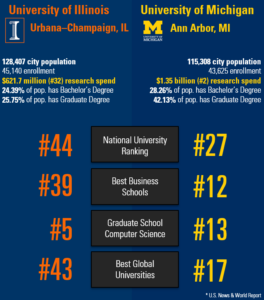
Recap: This fall there are 8 home football games out of the 12 game regular season. We used this rather unprecedented home game advantage as an impetus to ask ourselves how we stack up against other, similar regions. How does Ann Arbor compare to other college towns in the US?
After a week with no football (gasp!) and an away game before that, not only is this weekend’s game at home, but it is also Michigan’s Homecoming Game! Brace yourselves for perfect fall weather and a healthy influx of fans.
The history of “Homecoming” in the United States dates back to the 19th century, as a series of events meant to welcome back alumni and former residents usually organized around a central sporting event (these days, football). The accompanying events vary, often including a parade, and some kind of social occasion like a banquet or a dance.
In American Homecoming tradition, The University of Illinois occupies an important place due to an account of their first homecoming game:
“In 1910 two Illini seniors, Clarence Williams and Elmer Ekblaw, began planning an event centered around the annual Illinois-Chicago rivalry. For the previous seven years, Illinois had lost to the Chicago Maroons and their coach, Amos Stagg. Williams and Ekblaw hoped to reverse this losing streak by planning an event that bolstered school spirit at its core.
Support for the event took hold among the student body, faculty and local businesses. The school’s Council of Administration set aside October 14 as an official day of homecoming. This first homecoming would be an experiment, the success of which would determine the future of the school’s homecoming. It turned out to be an event bigger than anyone had anticipated.
Illinois’ campus was blanketed in a sea of orange and blue. Five thousand extra seats had to be furnished by the athletic association to accommodate the game’s large number of attendees. Twelve thousand alumni, students were on hand to witness a 3-0 victory for Illinois.” source
It’s doubtful that we will need to add any extra seats to the Big House for this weekend’s game… but you can bet every single one will be occupied.
And now, our usual contextual setting for the statistics you’re about to see comparing Ann Arbor to Urbana-Champaign:
- This comparison is an odd one for one particular reason: Urbana and Champaign are distinct cities and statistically separate. However, they are geographically linked (as “twin” cities) and are often cited as one.
- Their combined population is very similar to Ann Arbor (with a difference of about 13000).
- Total enrollment at University of Illinois is also similar to University of Michigan – with slightly more students enrolled at Illinois.
- Urbana-Champaign sits almost equidistant between Indianapolis and Chicago, with about a 2 hour drive to either. (Which contrasts to Ann Arbor’s relative proximity to Detroit).
ICYMI – Here are links to the series on our athletic (and economic) competition!
